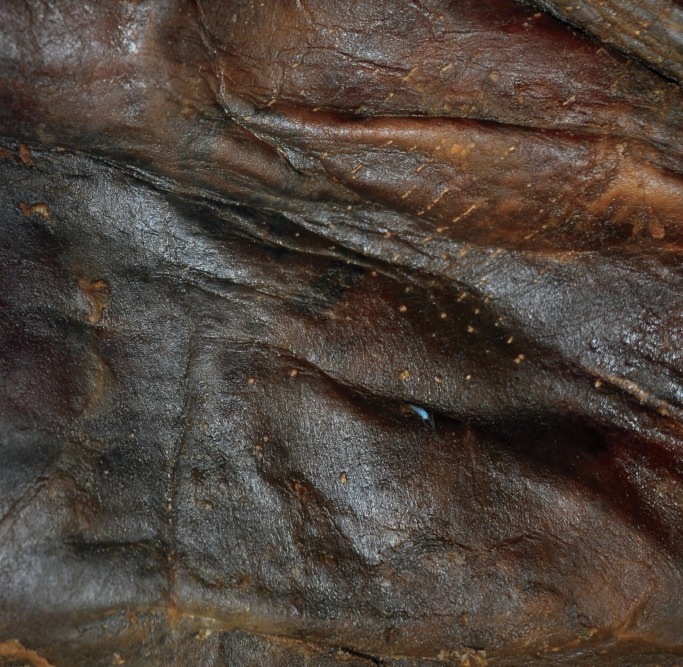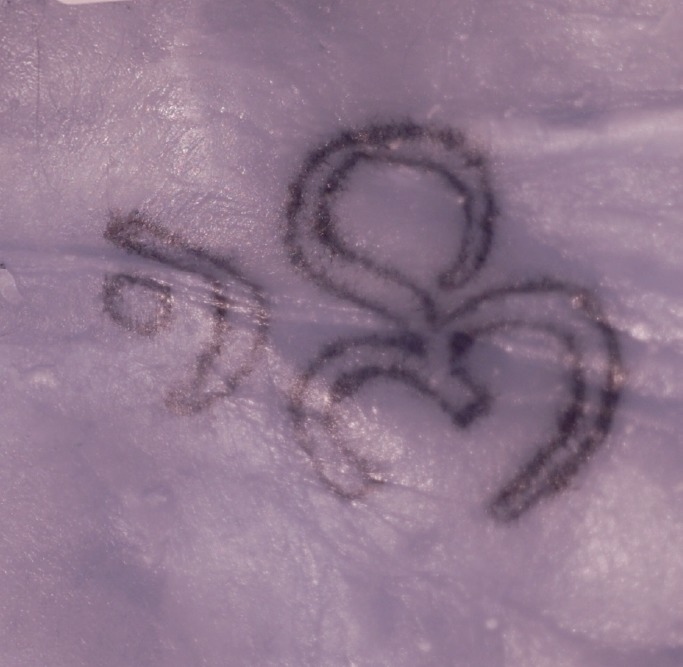
One of the most important responsibilities of a coroner's or medical examiner's office is identification of the deceased. In most instances, identification is easily established through visual means. However, some cases require alternative means of identification, such as comparisons using fingerprints, dental records, radiographs (i.e., surgical hardware), or even DNA analysis. Identification of decomposing bodies can be particularly challenging since the changes of decomposition often preclude simple visual identification or identification via fingerprint comparison. Decedents may be edentulous, lack dental history (there are either no prior procedures or records may not be obtainable), or the teeth may have been damaged or destroyed, rendering dental comparison difficult. Various techniques, such as rehydration of mummified tissue, have been developed and tested to facilitate identification of decomposed bodies (1, 2). We present a case where identification of a mummified body was established utilizing infrared (IR) photography to visualize a tattoo.

A 27-year-old man was discovered slumped over sitting in the driver's seat of his car inside a closed garage. The keys were in the ignition and the ignition was in the on position. An empty bottle of vodka was on the passenger seat. Presumptive identification was made based on the vehicle being registered to a relative; the relative reported that the car had been loaned to an individual in the family who hadn't been seen or heard from for approximately six months. At the time of discovery, the body was in an advanced state of decomposition characterized by dry, leathery skin and other mummified features. Fingerprints could not be obtained, and no dental hardware was in place. There were no old dental records available for comparison.
After inquiring about tattoos or other identifying features, a relative indicated that the decedent had a tattoo of a religious symbol on his arm. The body was carefully examined for any evidence of a tattoo. A dark discoloration was faintly appreciated against the mummified skin on the anterior aspect of the right forearm. An IR photograph clearly demonstrated a tattoo, an Aum (or Om) symbol. The Aum symbol, written in Sanskrit, represents a core belief system of both Hinduism and Buddhism and stands for loving, kindness, compassion, sympathetic joy, and equanimity, among other virtues. A relative confirmed that this was indeed the tattoo that the decedent was known to have, and identification was established. Death was ultimately attributed to probable carbon monoxide poisoning; the manner of death was deemed undetermined since death could have been an accident or suicide.
Infrared refers to a portion of the electromagnetic spectrum whose characteristic wavelengths (800 nm – 1 mm) are longer than the typical range of wavelengths encompassing visible light (400 nm – 800 nm) (3). One advantage of IR is its ability to penetrate skin and expose otherwise invisible or barely visible features of objects. This has proven valuable in both medical and forensic applications, including for visualization of bloodstains, gunpowder residue, and tattoos for identification purposes (4, 5). Historically, the process to generate IR-based pictures was difficult and burdensome, requiring specialized photography skills and equipment. Currently, various characteristics of objects only visible through IR imaging can be discerned with a digital camera equipped with a specialized filter and lens attuned to the IR spectrum. In our case, a Nikon D80 digital camera was converted to utilize an internal IR filter. While tutorials are available, our office elected to have the camera serviced by professionals due to risk of damaging the camera (i.e., disrupting the ability to focus on images). Essentially, the camera is disassembled and the internal hot mirror filter is replaced with an infrared filter (6).
A conventional Nikon D90 and a Nikon D80 converted for IR photography were used to take digital images of the decedent's tattoo. Both photographs were taken using an 18-70 mm DX Nikon lens fitted with an ultraviolet (UV) filtering protector and utilizing the program setting that allows the camera to adjust shutter speed and aperture for optimal exposure. Additionally, the conventional photo was produced using the D90's built-in flash while the IR photograph was taken using an IR D80 with a top-mounted Nikon Speed-light SB-80DX flash. For macro images, built-in flash units generally provide enough IR exposure, but most images are best illuminated using an additional flash source. Similar IR images can be accomplished using a lens filter technique accomplished by mounting a lens-specific IR filter to a conventional camera and placing the camera on a tripod. A tripod is necessary for extended open shutter periods that allow adequate exposure to IR spectrum light. How-tos and technique specific tutorials are abundantly available online. Using a Google search, we found two articles particularly informative regarding basic infrared concepts and forensic applications (7, 8). For individuals who would like to understand more about IR photography, such as different types of lenses and how to process the image, these articles from Digital Camera World and Photography Life may be helpful (9, 10).
Lastly, ultraviolet light, which encompasses a range of wavelengths shorter than the visible light spectrum, has also been used in a similar fashion as IR imaging and can also be useful for various forensic purposes (11).
Footnotes
Ethical Approval: As per Journal Policies, ethical approval was not required for this manuscript
Statement of Human and Animal Rights: This article does not contain any studies conducted with animals or on living human subjects
Statement of Informed Consent: No identifiable personal data were presented in this manuscript
Disclosures & Declaration of Conflicts of Interest: The authors, reviewers, editors, and publication staff do not report any relevant conflicts of interest
Financial Disclosure: The authors have indicated that they do not have financial relationships to disclose that are relevant to this manuscript
References
- 1).Hernandez G., Hess G.L. Rehydrating mummified hands: the Pima County experience. Acad Forensic Pathol. 2014. Mar; 4(1): 114–7. [Google Scholar]
- 2).Fields R., Molina D.K., A novel approach for fingerprinting mummified hands. J Forensic Sci. 2008. Jul; 53(4): 952–5. PMID: 18489553. 10.1111/j.1556-4029.2008.00768.x. [DOI] [PubMed] [Google Scholar]
- 3).Gigahertz-optik [Internet]. Newburyport (MA): Gigahertz-Optik, Inc; c2016. The wavelength range of optical radiation; [cited 2016. Feb 29]. Available from: http://light-measurement.com/wavelength-range/. [Google Scholar]
- 4).Oliver W.R., Leone L., Digital UV/IR photography for tattoo evaluation in mummified remains. J Forensic Sci. 2012. Jul; 57(4): 1134–6. PMID: 22409382. 10.1111/j.1556-4029.2012.02101.x. [DOI] [PubMed] [Google Scholar]
- 5).Chun-Yen, Lin A.C., Hsieh H.M. et al. Forensic applications of infrared imaging for the detection and recording of latent evidence. J Forensic Sci. 2007. Sep; 52(5): 1148–50. Epub 2007 Jul 23. PMID: 17645744. 10.1111/j.1556-4029.2007.00502.x. [DOI] [PubMed] [Google Scholar]
- 6).Life Pixel Infrared [Internet]. Mukilteo (WA): Life Pixel Infrared; c2016. Nikon D80 DIY digital infrared conversion tutorial; [cited 2016. Feb 29]. Available from: http://www.lifepixel.com/tutorials/infrared-diy-tutorials/nikon-d80-ir. [Google Scholar]
- 7).De Broux S., Kay McCaul K., Shimamoto S. Infrared photography [Internet]. Wildomar (CA): Crime Scene Resources Inc; 2007. Jan 29 [cited 2016 Mar 13]. Available from: http://www.crime-scene-investigator.net/Infrared_Photography_research_paper.pdf. [Google Scholar]
- 8).Kringle C., Reiter K. UV/IR injury photography [Internet]. Evid Technol. 2008. Sep-Oct [cited 2016 Mar 13]; 6(5). Available from: http://www.evidencemagazine.com/index.php?option=com_content&task=view&id=106. [Google Scholar]
- 9).Digital Camera World [Internet]. Bath (UK): Future Publishing Limited; c2016. Infrared photography tutorial: how to capture striking images beyond the visible colour spectrum; 2015 Sep 4 [cited 2016. Mar 13]. Available from: http://www.digitalcameraworld.com/2015/09/04/infrared-photography-tutorial-how-to-capture-striking-images-beyond-the-visible-colour-spectrum/. [Google Scholar]
- 10).Photography Life [Internet]. [place unknown]: Photography Life; c2016. Introduction to infrared photography; 2012. Mar 12 [cited 2016 Mar 13]. Available from: https://photographylife.com/introduction-to-infrared-photography. [Google Scholar]
- 11).Scheirs S., Malgosa A., Galtes I., The use of ultraviolet light to reveal and enhance burned areas on human bone. Forensic Sci Med Pathol. 2015. Dec; 11(4): 618–21. PMID: 26343035. 10.1007/s12024-015-9710-8. [DOI] [PubMed] [Google Scholar]


